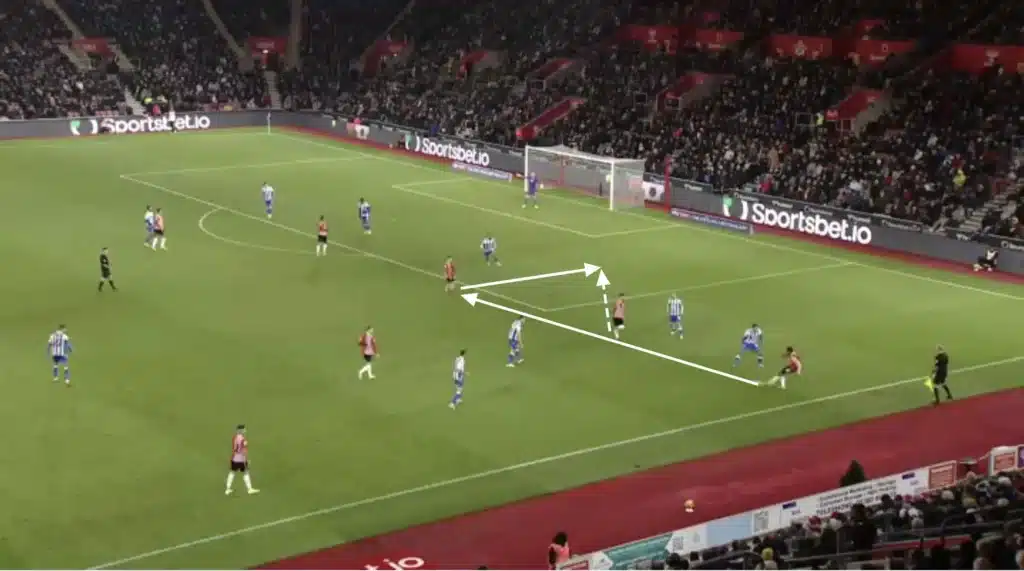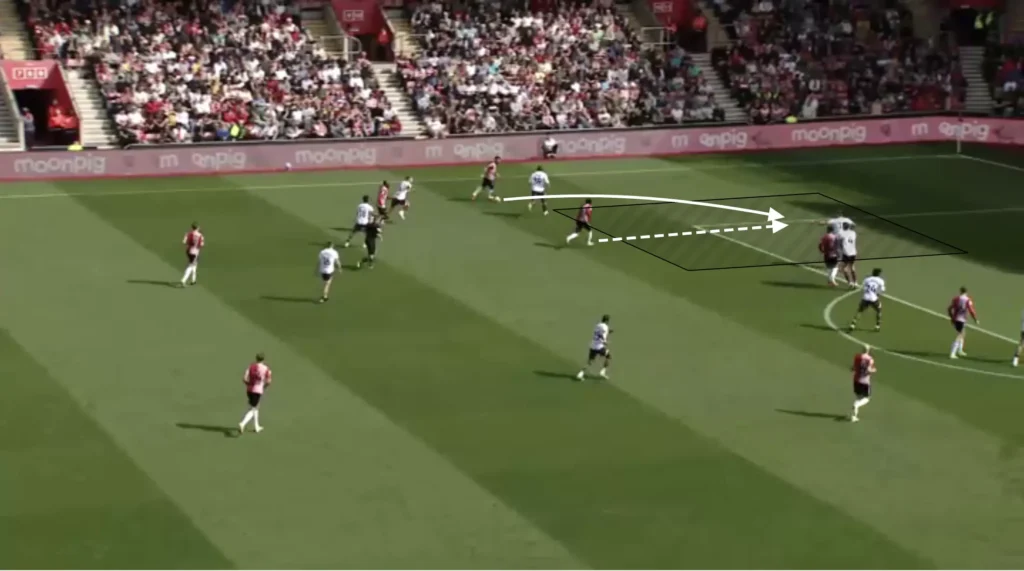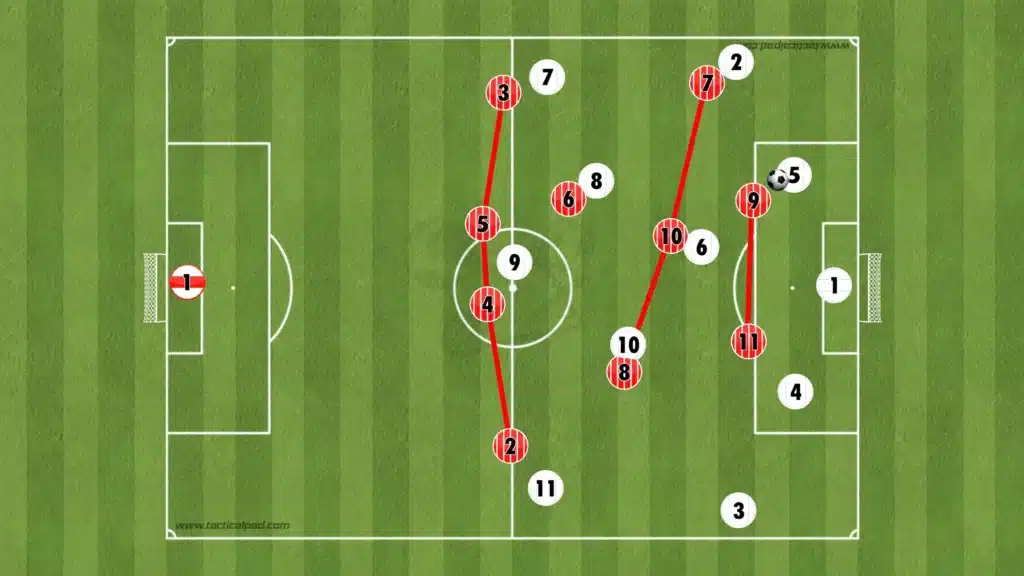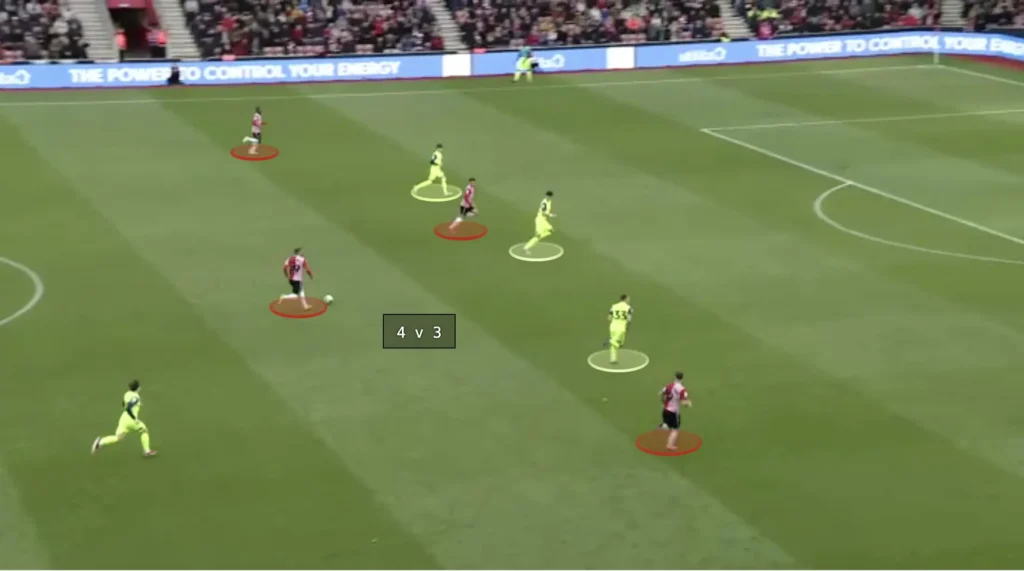In this article, we delve into the tactical intricacies of Southampton under the management of Russell Martin. Known for his modern and progressive approach, Martin has implemented a distinctive style that has transformed the team’s dynamics. This tactical analysis will explore the key elements of his strategy, including formations, pressing schemes, and attacking patterns. By examining these components, we aim to understand how Russell Martin’s tactics shape Southampton’s performances and influence their success on the pitch. Let’s uncover the strategic blueprint behind Southampton’s evolution under Russell Martin’s stewardship.
Build-up
Low Build-up
Martin sets his team up in a 1-4-2-2-2 formation in the low build-up. They use two dropping number-tens and two wingers, looking to attract opposition players, opening up the space in behind.


This formation, popularized by Roberto De Zerbi, questions the opposition center-backs, forcing them to make difficult decisions. If they push up on the dropping number-tens, the space behind them opens up, giving the winger a 1v1 against the fullback. However, If they do not push up the number-tens, a numerical superiority gets created in the midfield, allowing Southampton to play through the press.


High Build-up
In the high build-up, Martin’s Southampton sets up in a 1-2-3-5 formation, inverting the fullbacks and pushing a holding midfielder up as an attacking midfielder.


Inverted Fullbacks
The Southampton fullbacks usually invert during the build-up, creating more options in the center and less space between the players. Martin likes this because he prioritizes playing through the middle. He needs one player high and wide to pull apart the backline while the rest create numerical advantages in the midfield areas. This builds good conditions in defensive transitions, allowing more players to press when they lose the ball. Another purpose for keeping most of the players central is that it lessens the space between them. This shortens the length of the passes, which naturally shortens the time between passes. This means the opposition players will have less time to push up and press, giving the Southampton players more time and control.


High Backline
A massive aspect of Southampton’s high possession build-up is they keep a high backline. This helps in the counterpress because they get closer to the center. Having more players close to the center who can win the ball back makes it difficult for the opposition to do anything when they win possession. Furthermore, the high backline shortens the distance between players, shortening the time and length of the passes and preventing the opposition from pushing up their defense.


Linking with the Striker
Russel Martin likes to create central overloads when attacking the opposition. Therefore, the Southampton striker, Adam Armstrong, often drops during the build-up. When the striker drops, Southampton unlock more ways of beating the opponent’s defense. They can pass the ball to the striker, who can find an attacking midfielder in the pocket or play a one-touch pass out to the winger. If the center-back pushes up on the dropping striker, Southampton will exploit the space in behind the backline.

Third-man
Russel Martin likes it when his team plays through the opposition when possible. One vital tool that they often use is the third-man principle. This means using a third player to reach a free player whose passing lane is blocked.
One example of Southampton using the third-man principle is when they play against one striker. When the striker presses one of the center-backs, the other one will be open, however, the passing lane will be blocked. They have to use another player to find the open player. The center-back will pass the ball to the number-six, who has the angle to find the open center-back with a one-touch pass.

The Southampton players also use third-man combinations to find the attacking midfielders in the pockets. The opponents always try to block the passing lane from the ball holder to the attacking midfielder, meaning Southampton must use a pass to another player in between. They will often use the number-six and the wingers in this way, using them to find open players in the pockets.


Another common third-man pattern in Southampton’s build-up is a rotation where an attacking midfielder drags away an opposition midfielder to open the passing lane to the striker. When the fullback or sometimes the winger has the ball, the attacking midfielder will run up towards the space between the opposition center-back and fullback. An opposition midfielder often follows the run, which opens the passing lane from the fullback/winger to the striker. When the ball gets played to the striker, the center-backs usually push up, not allowing the striker to turn. This opens the space for the attacking midfielder, who has continued the run into the space between the center-back and the fullback. The striker will find the attacking midfielder with a one-touch pass, creating a dangerous goalscoring opportunity.


Numerical Advantages
Another massive aspect of Southampton’s high build-up is their ability to create numerical advantages against the opposition’s defensive line. Their front five naturally becomes numerically superior against a back four, which they are great at taking advantage of.


When the defending team is positioned on one side, the weak-side fullback becomes vulnerable to the long switch of play due to the 1v2 against Southampton’s winger and attacking midfielder. Martin’s team often capitalizes on this by getting the ball to the winger and creating many opportunities from 2v1 situations on the wing and in the half-spaces.

Final Third
Attacking the Half-Space
Southampton has proven to be a great team in the final third. They always create many chances, mainly by attacking the space between the opposition center-back and fullback. They primarily do this from the wide areas with underlaps from the attacking midfielders or sometimes the inverted fullbacks.


The winger can either play the ball to the underlapping player, who can cross to a teammate in the box, or take the ball inside to combine with an attacker or shoot.
Martin’s team also exploits the space between the center-back and the fullback by playing through-balls from the midfield or backline to a running winger or attacking midfielder.

Many Players in the Box
The attacking midfielders and wingers always look to make runs into the box when the ball is in the final third, often getting four or five players into these areas to create overloads. The numerical advantages in the box force the defending team to make decisions and leave some players open.


Southampton will score many of their goals from crosses to the wingers at the back post. The opposition fullback will often be preoccupied with a Southampton attacking midfielder, which leaves massive space at the back post for the winger to attack.


Martin also positions many Southampton players outside the box, ready for the second balls and cut-backs. They always succeed in pushing down the opposition’s defense, which opens the space in front of the backline. Southampton will often find their midfielders in these spaces, who can shoot or combine with an attacker to create goalscoring opportunities.


Defending
High Press
Martin’s Southampton presses the opposition high when possible and does so in a 1-4-1-3-2 formation:


Many teams use a 1-4-3-3 formation in the build-up, which would give them a numerical advantage low down against Southampton’s six midfielders and forwards. Martin solves this by leaving the opposition’s weak-side fullback open and going man-to-man on the rest of the players when the ball gets played to one of the sides. The ball-side wide-midfielder pressures the opposition ball-side fullback, the holding midfielder pushes over on the opposition ball-side number-eight, and the weak-side wide-midfielder tucks in to control the opposition weak-side number-eight.


They can do this because the pass from one side to the other is too difficult for the ball-holder to make, and if he makes it, the Southampton players have enough time to come across and win the ball. This system also gives Southampton a numerical advantage against the opposition striker, giving them more control when defending long balls.
Low Press
In the low press, Southampton have used a few different formations, but usually, they set up in a 1-4-1-4-1 formation. They look to set up in a mid-block, always trying to close the center, forcing the opposition out wide. Martin’s team always stays compact, mainly closing the space between the midfield and backline.

They also look to squeeze the pitch when defending. This means constantly pushing the team up as much as possible. Every time the opponent plays a slow, sideways pass or a back pass, Southampton’s first line of pressure pushes up, with the rest of the team following to stay compact. When the next pass comes, they push up even more, forcing the opponent back even more. They do this because it pushes the opponent further away from the Southampton goal, making it harder to create chances.


Transitions
Defensive Transitions
Positioning many players centrally, creating a numerical advantage in the midfield, creates good conditions in defensive transitions. Many players close to the ball after losing possession means that many players can work towards regaining possession. Therefore, Southampton often successfully regains possession directly after losing it.


Offensive Transitions
Russel Martin also wants his team to counterattack in their offensive transitions. They do this with a high tempo, often attacking the spaces between the center-backs and fullbacks.

In addition, keeping many players centrally while defending enables them to incorporate more players into the counterattacks.

Final Thoughts
In conclusion, Russell Martin’s tactical approach at Southampton reflects a modern and proactive football philosophy. His emphasis on a fluid build-up, intelligent positioning, and relentless pressing showcases a commitment to an attractive, possession-based style. The strategic use of formations and the focus on exploiting space demonstrate Martin’s deep understanding of the game.
Southampton’s performances under Martin marked by their adaptability and tactical discipline have made them a formidable side in both attack and defense. As the team continues to evolve, fans can look forward to an exciting brand of football that balances creativity with structure. Russell Martin’s influence is clearly steering Southampton toward a promising future, with a tactical blueprint that is both innovative and effective.
